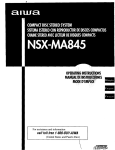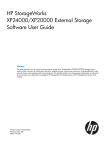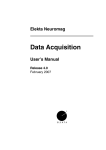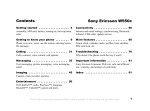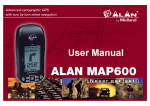Download Motorola MD207R Two-Way Radio User Manual
Transcript
• ANATEL ANNEX to Resolution No. 303 of July 2, 2002. • ANATEL ANNEX to Resolution No. 533 of September 10, 2009. To ensure optimal radio performance and make sure human exposure to radio frequency electromagnetic energy is within the guidelines set forth in the above standards, always adhere to the following procedures. Two-Way Radio Portable Radio Operation and EME Exposure User Guide Antenna Care Use only the supplied or an approved replacement antenna. Unauthorized antennas, modifications, or attachments could damage the radio and may violate FCC regulations. Do NOT hold the antenna when the radio is “IN USE.” Holding the antenna affects the effective range. Body-Worn Operation To maintain compliances with FCC/Health Canada RF exposure guidelines, if you wear a radio on your body when transmitting, always place the radio in a Motorola-supplied or approved clip, holder, holster, case or body harness for this product. Use of non-Motorola-approved accessories may exceed FCC/Health Canada RF exposure guidelines. If you do not use one of the Motorola-supplied or approved body-worn accessories and are not using the radio held in the normal use position, ensure the radio and its antenna are at least 1 inch (2.5 cm) from your body when transmitting. Data Operation If applicable, when using any data feature of the radio with or without an accessory cable, position the radio and its antenna at least one inch (2.5 cm) from the body. KEM-ML36801-27 MD207 Series Approved Accessories 53724: Remote Speaker with Push-to-Talk Microphone 53727: Earbud with Push-to-Talk Microphone 53728: Flexible Ear Receiver Electromagnetic Interference/Compatibility Note: Nearly every electronic device is susceptible to electromagnetic interference (EMI) if inadequately shielded, designed or otherwise configured for electromagnetic compatibility. This device complies with Part 15 of the FCC Rules. Operation is subject to the following two conditions: 1. This device may not cause harmful interference; and 2. This device must accept any interference received, including interference that may cause undesired operation. Facilities To avoid electromagnetic interference and/or compatibility conflicts, turn off your radio in any facility where posted notices instruct you to do so. Hospitals or health care facilities may be using equipment that is sensitive to external RF energy. For More Information For further information, you may call Motorola at 1-800-638-5119 (U.S.), or e-mail us at [email protected] or visit us on the Internet at www.motorolasolutions.com/talkabout. Safety and General Information Important Information on Safe and Efficient Operation Read This Information Before Using Your Radio. The information provided in this document supersedes the general safety information in user guides published prior to December 1, 2002. Transmit and Receive Procedure Your two-way radio contains a transmitter and a receiver. To control your exposure and ensure compliance with the general population/uncontrolled environment exposure limits, always adhere to the following procedure: • Transmit no more than 50% of the time. • To receive calls, release the Push-to-Talk (PTT) button. • To transmit (talk), press the PTT button. Transmitting 50% of the time, or less, is important because the radio generates measurable RF energy exposure only when transmitting (in terms of measuring standards compliance). Exposure to Radio Frequency Energy Your Motorola two-way radio complies with the following RF energy exposure standards and guidelines: • United States Federal communications Commission, Code of Federal Regulations; 47CFR part 2 sub-part J. • American National Standards Institute (ANSI)/Institute of Electrical and Electronic Engineers (IEEE) C95. 1-1992. • Institute of Electrical and Electronics Engineers (IEEE) C95.1-1999 Edition. • International Commission on Non-Ionizing Radiation Protection (ICNIRP) 1998. • Ministry of Health (Canada) Safety Code 6. Limits of Human Exposure to Radiofrequency Electromagnetic Fields in the Frequency Range from 3 KHz to 300 GHz, 1999. • Australian communications Authority Radiocommunications (Electromagnetic Radiation—Human Exposure) Standard, 2003. atmosphere can cause an explosion or fire resulting in bodily injury or even death. Note: The areas with potentially explosive atmospheres referred to above include fueling areas such as below decks on boats, fuel or chemical transfer or storage facilities, areas where the air contains chemicals or particles (such as grain, dust or metal powders) and any other area where you would normally be advised to turn off your vehicle engine. Areas with potentially explosive atmospheres are often—but not always—posted. the ribbon attached 3. Remove the NiMH battery pack by gently pulling PTT to the radio. 4. Reposition the battery cover and press down to secure. Removing the Three AA Alkaline Batteries (Optional Accessory) 1. Turn the radio off. 3. Remove each alkaline battery by gently pulling the ribbon attached to the radio and easing each battery out individually. Antennas Do not use any portable radio that has a damaged antenna. If a damaged antenna comes into contact with your skin, a minor burn can result. 4. Reposition the battery cover and press down to secure. PTT Volume Scroll (High) / Weather Volume Scroll (Low) Exercise care when removing NiMH or AA batteries. Do not use sharp or conductive tools to remove either of these batteries. Battery Charger Safety Instructions: 1. Do not expose the charger to rain or snow. 2. Connect the AC power adaptor plug into the recharging jack at the bottom of the radio. (The adaptor charges two radios.) 2. Do not operate or disassemble the charger if it has received a sharp blow, or has been dropped or damaged in any way. 3. Plug the AC power supply into a standard wall outlet. Notes: • The battery icon will scroll while the battery pack is being charged. • When moving between hot and cold temperatures, do not charge the battery until the battery temperature acclimates (usually about 20 minutes). • For optimal battery life, unplug the charging adaptor within 16 hours. Do not store the radio while connected to the charger. Display Screen Guide 3. Never alter the AC cord or plug provided with the unit. If the plug will not fit the outlet, have the proper outlet installed by a qualified electrician. An improper condition can result in a risk of electric shock. 4. To reduce the risk of damage to the cord or plug, pull the plug rather than the cord when disconnecting the charger from the AC receptacle. 5. To reduce the risk of electric shock, unplug the charger from the outlet before attempting any maintenance or cleaning. 7. Make sure the cord is located so it will not be stepped on, tripped over or subjected to damage or stress. Medical Devices – Pacemakers The Advanced Medical Technology Association recommends that a minimum separation of 6 inches (15 cm) be maintained between a handheld wireless radio and a pacemaker. These recommendations are consistent with the independent research by and recommendations of the U.S. Food and Drug Administration. • The pins on the plug of the extension cord are the same number, size and shape as those on the plug of the charger. Numbers for Channel, Call Tone Numbers for Codes Medical Devices – Hearing Aids Some digital wireless radios may interfere with some hearing aids. In the event of such interference, you may want to consult your hearing aid manufacturer to discuss alternatives. Medical Devices - Other If you use any other personal medical device, consult the manufacturer of your device to determine if it is adequately shielded from RF energy. Your physician may be able to assist you in obtaining this information. Safety and General Use While Driving Check the laws and regulations regarding the use of radios in the area where you drive, and always obey them. If you do use your radio while driving, please: • Give full attention to driving and to the road. • Use hands-free operation, if available. • Pull off the road and park before making or answering a call if driving conditions so require. The use of a two-way radio while engaged in activities requiring concentration may cause distraction or otherwise impair your ability to safely participate in such activities. Always use technology safely. Do not place a portable radio in the area over an air bag or in the air bag deployment area. Air bags inflate with great force. If a portable radio is placed in the air bag deployment area and the air bag inflates, the radio may be propelled with great force and cause serious injury to occupants of the vehicle. Potentially Explosive Atmospheres Turn off your radio prior to entering any area with a potentially explosive atmosphere. Only radio types that are especially qualified should be used in such areas as “Intrinsically Safe.” Do not remove, install or charge batteries in such areas. Sparks in a potentially explosive Low Battery Alert power you In addition to your battery meter showing how much battery PTT have, your radio will beep to alert you to the factPTTthat your batteries are low. Attaching and Removing the Belt Clip 1. Attach belt clip to pocket or belt strap. PTT 2. Align the belt clip post with the hole in the back of PTT the radio. 3. Gently push until the clip clicks in place. To Remove 1. Push down on the release tab at the top of the belt clip to PTT release the catch. 2. Pull the belt clip away from the back of the radio. • The extension cord is properly wired and in good electrical condition. • The extension cord size is 18 AWG for lengths up to 100 feet, and 16 AWG for lengths up to 150 feet. PTT Weather Alert Turning Your Radio On and Off PTT 9. The supply cord of the AC adaptor cannot be replaced. If the cord is damaged, call customer service at 1-800-638-5119 or e-mail us at [email protected]. PTT 1. To turn on, press and hold and the radio beeps. 2. To turn off, press and hold until a channel number appears until the display goes blank. Volume Scroll Setting the Volume (High) / Weather Scroll Volume Press to increase or to decrease the volume. The volume level Volume Scroll (High) / Weather (Low) flashes and VOL Volume Scroll displays. For a fax: Contact the Fax-0n-Demand system 1-202-418-0177 For mail service: Call the FCC Forms Hotline 1-800-418-FORM (3676) If you have questions about the FCC License: Call the FCC 1-888-CALL-FCC (225-5322) Changes or modifications not expressly approved by Motorola may void the user’s authority granted by the FCC to operate this radio and should not be made. To comply with FCC requirements, transmitter adjustments should be made only by or under the supervision of a person certified as technically qualified to perform transmitter maintenance and repairs in the private land mobile and fixed services as certified by an organization representative of the user of those services. Replacement of any transmitter component (crystal, semiconductor, etc.) not authorized by the FCC equipment authorization for this radio could violate FCC rules. You can find the label with the FCC ID in the battery compartment. Note: Use of this radio outside the country where it was intended to be distributed is subject to government regulations and may be prohibited. 3. Press PTT (High) / Weather Volume or Scroll to select Volume Scroll a channel. (High) / Weather (Low) Volume Scroll to confirm or to continue (Low) Volume Scro (High) / Wea Volume Scro (Low) set up. Channels and Frequencies Volume Scroll (High) / Weather Volume Scroll Frequency Frequency (Low) Channel Description Channel Description (MHz) (MHz) 1 462.5625 GMRS/FRS 12 467.6625 FRS 2 462.5875 GMRS/FRS 13 467.6875 FRS 3 462.6125 GMRS/FRS 14 467.7125 FRS 4 462.6375 GMRS/FRS 15 462.5500 GMRS 5 462.6625 GMRS/FRS 16 462.5750 GMRS 6 462.6875 GMRS/FRS 17 462.6000 GMRS 7 462.7125 GMRS/FRS 18 462.6250 GMRS 8 467.5625 FRS 19 462.6500 GMRS 9 467.5875 FRS 20 462.6750 GMRS 10 467.6125 FRS 21 462.7000 GMRS 11 467.6375 FRS 22 462.7250 GMRS Selecting the Interference Eliminator Code Interference Eliminator Codes help minimize interference by blocking transmissions from unknown sources. Your radio has 121 Interference Eliminator Codes. Codes 1 – 38 are the standard analog codes that appear onPTTother FRS/GMRS radios. Codes 39 – 121 are additional digital codes added for superior interference protection. 0 is the off position, no analog or digital codes are enabled. PTT To set the code for a channel: 1. Press until the code Volume Scrollstarts to flash. 2. Press 3. Press PTT (High) / Weather Volume or Scroll to select Volume Scroll the code. (High) / Weather (Low) Scrollthe code setting or Volume to save (Low) Volume Scroll (High) / Weather Volume Scroll (Low) to continue set up. Scroll channel using this procedure. An You can set a different codeVolume for each (High) / Weather Volume extended press of or Scroll allows you to scroll through the Interference Volume Scroll Volume Scroll (High) / Weather (Low) / Weather Codes rapidly so you can quickly reach the code you (High) want. Volume Scroll Volume Scroll (Low) Note: You must set the Interference Eliminator Code to(Low) 0 on a radio that uses Interference Eliminator Codes to communicate with radios that do Volume Scroll Interference Eliminator Codes. Select 0 for “no tone, no code” not have (High) / Weather and OFF Scroll will flash on your radio’s display. Volume (Low) Volume Scroll (High) / Weather Scroll VolumeCODE (Low) 1 INTERFERENCE ELIMINATOR TONE / CODE VALUES (Hz) CODE (OCTAL) CODE (OCTAL) 023 81 315 2 71.9 40 025 82 331 3 4 5 6 7 8 9 10 11 12 74.4 77.0 79.7 82.5 85.4 88.5 91.5 94.8 97.4 100.0 41 42 43 44 45 46 47 48 49 50 026 031 032 043 047 051 054 065 071 072 83 84 85 86 87 88 89 90 91 92 343 346 351 364 365 371 411 412 413 423 13 103.5 51 073 93 431 14 107.2 52 074 94 432 15 110.9 53 114 95 445 16 114.8 54 115 96 464 17 118.8 55 116 97 465 18 123.0 56 125 98 466 19 127.3 57 131 99 503 20 131.8 58 132 100 506 21 136.5 59 134 101 516 22 141.3 60 143 102 532 23 146.2 61 152 103 546 24 151.4 62 155 104 565 Pressing and holding for three seconds allows you to listen to the volume level of the radio when you are not receiving. You can also 25 156.7 63 156 105 606 26 162.2 64 162 106 612 27 167.9 65 165 107 624 Installing the Three AA Alkaline Batteries (Optional Accessory) 1. Turn the radio off. press 28 173.8 66 172 108 627 29 179.9 67 174 109 631 30 186.2 68 205 110 632 2. With the back of the radio facing you, lift the battery latch up to release the battery cover and remove the cover. Push-to-Talk Timeout Timer To prevent accidental transmissions and save battery life, the radio emits a continuous warning tone and stops transmitting if you press V PTT for 60 continuous seconds. 31 192.8 69 223 111 654 32 203.5 70 226 112 662 33 210.7 71 243 113 664 34 218.1 72 244 114 703 35 225.7 73 245 115 712 36 233.6 74 251 116 723 37 241.8 75 261 117 731 38 250.3 76 263 118 732 77 265 119 734 78 271 120 743 79 306 121 754 80 311 (Low) If you wish to have the document faxed or mailed, or if you have questions, please use the following contact information: 2. Press . The channel number flashes. 39 FCC Licensing Information Your Motorola radio operates on General Mobile Radio Service (GMRS) frequencies and is subject to the Rules and Regulations of the Federal Communications Commission (FCC). The FCC requires that all operators using GMRS frequencies obtain a radio license before operating their equipment. To obtain the FCC forms, please visit the FCC’s Web site at wireless.fcc.gov/uls/index.htm?job=home to source form 605 and 159, which includes all the instructions you will need. Volume (High) / Volume (Low) PTT release 1. Briefly press and Volume Scroll 67.0 • Not carry the radio in the breast pocket. • Turn the radio OFF immediately if there is any reason to suspect that interference is taking place. Using the Plug-in Charging Adaptor The battery plug-in charger (adaptor) provides charging convenience for NiMH batteries in one or both radios. Charge the NiMH battery overnight (at least 16 hours) before using it for the first time. After the initial charge, an empty battery is fully charged within 14 hours. 1. Follow the steps above to install a NiMH battery pack. 8. An extension cord should not be used unless absolutely necessary. Use of an improper extension cord could result in a risk of a fire and/or electric shock. If an extension cord must be used, make sure that: • Use the ear opposite the pacemaker to minimize the potential for interference. Notes: • Exercise care when removing NiMH or AA batteries. Do not use sharp or conductive tools to remove either of these batteries. • Remove the batteries before storing your radio for extended periods of time. Batteries corrode over time and may cause permanent damage to your radio. Save these Instructions 6. Use of an attachment not recommended or sold by Motorola may result in a risk of fire, electric shock or personal injury. PTT Selecting the Channel Your radio has 22 channels. The channel is the frequency your radio uses to transmit. (See Channels and Frequencies table below.) 2. With the back of the radio facing you, lift the battery latch up to release the battery cover and remove the cover. Operational Cautions Batteries All batteries can cause property damage and/or bodily injury such as burns if a conductive material—like jewelry, keys or beaded chains— touch exposed terminals. The conductive material may complete an electrical circuit (short circuit) and become quite hot. Exercise care in handling any charged battery, particularly when placing it inside a pocket, purse or other container with metal objects. Menu Options 2. With the back of the radio facing you, lift the battery latch up to release the battery cover and remove the cover. PTT Blasting Caps and Areas To avoid possible interference with blasting operations, turn off your radio when you are near electrical blasting caps, in a blasting area, or in areas posted “Turn off two-way radios.” Obey all signs and instructions. Aircraft When instructed to do so, turn off your radio when onboard on aircraft. Any use of a radio must be in accordance with applicable regulations per airline crew instructions. People with pacemakers should: • ALWAYS keep the radio more than 6 inches (15 cm) from their pacemaker when the radio is turned ON. Removing the NiMH Battery Pack 1. Turn the radio off. Control Buttons Talking and Listening Getting Started Installing the Batteries Each radio uses 1 NiMH rechargeable battery pack or 3 AA alkaline batteries and beeps when the batteries are low. Installing NiMH Rechargeable Battery Pack 1. Turn the radio off. 2. With the back of the radio facing you, lift the battery latch up to release the battery cover and remove the cover. 3. Remove the NiMH battery pack from the clear plastic bag (do not disassemble or unwrap the battery pack). 4. Insert the NiMH battery pack with the diagram facing you. The ribbon should be underneath the battery pack and should wrap around the right side of the battery pack for easy removal. 5. Reposition the battery cover and press down to secure. 3. Insert the three AA alkaline batteries with + and - polarity as shown inside. The ribbon should be underneath the AA alkaline batteries and should wrap around the right side of the batteries for easy removal. To communicate, all radios in your group must be set to the same channel. 1. To talk, press and hold PTT . 2. When you are finished talking, release PTT . For maximum clarity, hold the radio two to three inches away from yourV mouth and speak directly into the microphone. Do not cover the microphone while talking. Talk Range Your radio is designed to maximize performance and improve transmission range. Do not use the radios closer than five feet apart. Monitor Button to check for activity on the current channel before you talk. PTT 4. Reposition the battery cover and press down to secure. V Radio Battery Meter The radio battery icon shows the radio battery charge level, from full to empty . When the radio has one segment left, the radio chirps periodically or after releasing PTT (Low Battery Alert). Continued on back MD207 Series Call Tone PTT PTT Setting and Transmitting Call Tones transmit different call tones to Numbers other radios in your group Your radio can for Codes Numbers for Channel, PTT alertTone them that you want to talk. You haveAlert 10 call tones from so you can Call Weather which to choose. 3. When the radio detects channel activity with ANY code (or NO code), it stops scrolling and you can hear the transmission. Any Interference Eliminator Code that may be in use by that party will be detected and PTT displayed. To set a call tone: 4. To respond and talk to the person transmitting, press PTT within five PTT Volume Scroll (High)seconds / Weather of the end of the transmission. The radio will transmit using the Volume Scroll newly detected Interference Eliminator Code. (Low) 1. With the radio on, short press untilPTT appears. The current call tone setting flashes. Volume Scroll (High) / Weather Volume or Scroll to change Volume Scroll and hear the (High) / Weather (Low)Weather Alert Volume Scroll (Low) to set the new call tone or 2. Press 5. The radio will resume scrolling through the channels five seconds after the end of any received activity. call tone. Volume Scroll Weather stop/ scanning, briefly press the key. 6. To (High) Volume Scroll (Low) Notes Scanning 1. If you press PTT while the radio is scrolling through inactive channels, the transmission will be on the “home channel”. Scanning will PTT resume five seconds after the end of your transmission. You may Volume Scroll press PTT to stop scanning at any time. to continue set up. 3. Press PTT To transmitNumbers your callfortone to other radios set Numbers to the same channel as Channel, for Codes Tone . press your radio,Call Note: Setting the call to 0 disables the call tone Volume Scroll (High) / Weather feature. Volume Scroll (Low) Transmitting a Talk Confirmation Tone You can set your radio to transmitPTTa unique tone when you finish PTT transmitting. It is like saying “Roger” or “Over” to let others know you are finished talking. (High) / Weather Scroll 2. If the radio stops on an undesired transmission, you mayVolume immediately (Low) Volume Scroll resume the scan by briefly pressing . Call Tone Numbers The for Codes appears. current PTT until setting On/Off flashes. Volume Scroll 2. Press 3. Press PTT set up. (High) / Weather Volume or Scroll to turn On or Off. Volume Scroll (High) / Weather (Low) Volume Scroll to set the talk confirmation (Low) tone or to continue Volume Scroll PTT 2. Press either 3. Press PTT the Weather to save the Weather Alert setting. 4. Press and hold Volume for 3 Scroll seconds to return to two-way mode. (High) / Weather Volume Scroll Volume Scroll Volume Scroll (High) (Low)/ Weather Volume Scroll (High) / Weather (High) / Weather Volume Scroll WEATHER Volume Scroll (Low) CHANNELS AND FREQUENCIES Volume Scroll (Low) (Low) CHANNEL RX (MHz) CHANNEL RX (MHz) CHANNEL RX (MHz) WX1 162.550 WX5 162.450 WX9 161.775 WX2 162.400 WX6 162.500 WX10 161.750 WX3 162.475 WX7 162.525 WX11 162.000 WX4 162.425 WX8 161.650 Warranty Products Covered Length of Coverage Consumer Two-Way Radio Products and Accessories purchased in the United States. Products and Accessories as defined above, unless otherwise provided for below. One (1) year from the date of purchase by the first consumer purchaser of the product unless otherwise provided for below. 1. Consumer Two-Way Radio Accessories. 1. Ninety (90) days from the date of purchase by the first consumer purchaser of the product. What Does this Warranty Cover? Subject to the exclusions contained to the right, Giant International Ltd. warrants the Motorola branded consumer two-way radios that operate via Family Radio Service or General Mobile Radio Service that it manufactures (“Products”), the Motorola branded or certified accessories sold for use with these Products that it manufactures (“Accessories”) to be free from defects in materials and workmanship under normal consumer usage for the period(s) outlined below. This limited warranty is a consumer’s exclusive remedy, and applies as follows to new Motorola branded Products and Accessories manufactured by Giant International Ltd., and purchased by consumers in the United States, which are accompanied by this written warranty: 2. Products and Accessories that are Repaired or Replaced. 2. The balance of the original warranty or for ninety (90) days from the date returned to the consumer, whichever is longer. (High) / Weather appears. The current setting On/Off will flash. Volume Scroll Volume Scroll (Low) (High) / Weather Volume or Scroll to turn On or Off. Volume Scroll (High) / Weather (Low) Volume Scroll confirm to continue set (Low) or 6. In "Advanced Scan" mode, the detected code will only be used for one transmission. You must note the code, exit scan, and set that detected code on that channel to permanently use the detected code. until Who is covered? This warranty extends only to the first consumer purchaser, and is not transferable. Scroll 3. AdjustVolume the/ volume . Lower Volume Scrollthe volume (High) Weather appropriately by pressing (Low) Scroll the accessory on your head or in your ear. placing beforeVolume (Low) 30,Scroll 60, 90) will flash. current setting (0, Volume mbers for Channel, Numbers forAlert Codes (High) / Weather Weather Volume Tone 2. Press or Scroll to setScroll the time to 30 minutes, Volume (High) / Weather (Low) Volume Scroll minutes. (Low) 60 minutes or 90 3. When you exit the MenuPTTmode, the setting timer will begin if you are not using the radio. 4. The screen shows PTT 5.Weather Press Alert to confirm or to exit Menu mode. Special Features Numbers for Channel, Note: The MD Series does not have VOX capabilities, and is only compatible with PTT headset accessories. What will GIANT INTERNATIONAL LTD. do? GIANT INTERNATIONAL LTD., at its option, will at no charge repair, replace or refund the purchase price of any Products or Accessories that does not conform to this warranty. We may use functionally equivalent reconditioned/ refurbished/ pre-owned or new Products, Accessories or parts. Weather Receiver This radio can tune in to broadcasts by the United States National Oceanic and Atmospheric Administration (NOAA) Weather Radio. You can listen to a weather channel (see “Weather Channels and Volume Scroll Frequencies” table for details) or set the radio to alert you to emergency (High) / Weather Volume Scroll weather broadcasts that interrupt routine broadcasts. When you listen to (Low) a weather channel, you cannot use the radio in scan mode or for twoway communications. . Volume Scroll (High) / Weather Numbers Volume Scroll for Codes Keypad Lock (Low) Call Tone PTT To avoid accidentally changing your radio settings you can lock your keypad: How to Obtain Warranty Service or Other Information? To obtain service or information, please call: USA Two-Way Radios NOAA has transmitters located throughout the United States. These transmitters broadcast watches, forecasts, and other information 24 hours a day. 1-800-638-5119 [email protected] For Accessories, please call the telephone number designated above for the product with which they are used. Note: NOAA weather radio stations are assigned to cover specific areas 1. Press and hold until displays. and service may be limited. Please check with your local weather office Volume Scroll and details, visit www.weather.gov/nwr in the US to for Channel,for frequency Numbers for or Codes 2. When in lock mode, you can turn the radio on and off, (High)receive, /Numbers Weather Call Tone view the appropriate transmitter for your area. Scroll transmit, send a call tone, and monitor channels. AllVolume other functions PTT (Low) are locked. The use of the NOAA logo does not provide an endorsement or implied Weather Alert PTT endorsement by NOAA’s National Weather Service. To unlock the radio, press and hold for a few seconds until no PTT longer displays. Numbers for Channel, Numbers for Codes Weather Alert (High) / Weather To start Scanning: Volume Scroll 1. Briefly press the key. The scan will appear in the display, (Low) and the radio will begin to scroll through all channel and code combinations. You will receive instructions on how to ship the Products or Accessories at your expense, to a GIANT INTERNATIONAL LTD. Authorized Repair Center. To obtain service, you must include: (a) a copy of your receipt, bill of sale or other comparable proof of purchase; (b) a written description of the problem; (c) the name of your service provider, if applicable; (d) the name and location of the installation facility (if applicable) and, most importantly; (e) your address and telephone number. Volume Scroll Turning Weather Channel Reception On and Off Call Tone (High) / Weather Scrollweather reception on, press and hold Volume 1. Volume To turn for 3 Scroll seconds. (Low) (High) / Weather Scanning Channels PTT Volume Scroll Volume Scroll 2. To turn off, press and hold for 3 seconds or turn the radio off and Weather Alert Use scan to search the 22 channels for transmissions from unknown (Low) (High) / Weather then back on. Volume Scroll parties, to find someone in yourNumbers group who has accidentally changed for Channel, Numbers for Codes (Low) Numbers for Channel, channels, or to quickly find unused channels for your own use. Call Tone Scanning for Weather Channel Call Tone The radio can scan for an active NOAA transmission automatically. There are 2 modes of scanning (basic and advanced) to make your Weather Alert search more effective. The "Basic Scan" mode uses the channel and 1. After turning "Weather Reception" on, briefly press the key. PTT PTT each of the 22 channels as you have set them. code combinations for 2. The scan icon will appear inPTTthe display, and the channel will The “Advanced Scan” mode will scan all channels for any and all codes, scrollPTTthrough the NOAA channels 1-7. detect any code in use, and use that code value temporarily for that 3. When the radio detects channel activity, it stops scanning and you channel. Volume Scroll Volume Scroll can hear the transmission. 4. You may resume the scan by briefly pressing 5. To stop scanning, briefly press . The scan (High) / Weather Weather Alert Volume or Scroll .Volume Scroll (High) / Weather (Low) Scroll disappear. iconVolume will (Low) Setting the Weather Channel Manually PTT If you know which frequency is correct for your location, refer to the Numbers for Codes "Weather Channels and Frequencies" table to manually set your radio to within five the appropriate weather channel. Numbers for Codes Numbers for Channel, PTT PTT PTT 4. The radio will resume scrolling through the channels five seconds after PTT the end of any received activity. 5. To stop scanning, briefly press the key. To start Advanced Scanning: Weather Alert 1. Set the Interference Eliminator Code to “0”. Volume Scroll (High) / Weather Volume Scroll will appear in the display, (Low) and the 2. Briefly press the key. The scan radio will begin to scroll through the channels. No Interference Eliminator Codes will filter what is heard. 1. After turning Weather Reception on, press Volume Scroll Volume Scroll flashes. Volume Scroll (High) / Weather . The current channel (High) / Weather Volume Scroll (High) / Weather Volume Scroll (Low) What Other Limitations Are There? ANY IMPLIED WARRANTIES, INCLUDING WITHOUT LIMITATION THE IMPLIED WARRANTIES OF MERCHANTABILITY AND FITNESS FOR A PARTICULAR PURPOSE, SHALL BE LIMITED TO THE DURATION OF THIS LIMITED WARRANTY, OTHERWISE THE REPAIR, REPLACEMENT, OR REFUND AS PROVIDED UNDER THIS EXPRESS LIMITED WARRANTY IS THE EXCLUSIVE REMEDY OF THE CONSUMER, AND IS PROVIDED IN LIEU OF ALL OTHER WARRANTIES, EXPRESS OR IMPLIED. IN NO EVENT SHALL MOTOROLA SOLUTIONS. INC. OR GIANT INTERNATIONAL LTD. BE LIABLE, WHETHER IN CONTRACT OR TORT (INCLUDING NEGLIGENCE) FOR DAMAGES IN EXCESS OF THE PURCHASE PRICE OF THE PRODUCT OR ACCESSORY, OR FOR ANY INDIRECT, INCIDENTAL, SPECIAL OR CONSEQUENTIAL DAMAGES OF ANY KIND, OR LOSS OF REVENUE OR PROFITS, LOSS OF BUSINESS, LOSS OF INFORMATION OR OTHER FINANCIAL LOSS ARISING OUT OF OR IN CONNECTION WITH THE ABILITY OR INABILITY TO USE THE PRODUCTS OR ACCESSORIES TO THE FULL EXTENT THESE DAMAGES MAY BE DISCLAIMED BY LAW. Some states and jurisdictions do not allow the limitation or exclusion of incidental or consequential damages, or limitation on the length of an implied warranty, so the above limitations or exclusions may not apply to you. This warranty gives you specific legal rights, and you may also have other rights that vary from state to state or from one jurisdiction to another. Patent and Copyright Information Manufactured, distributed or sold by Giant International Ltd., official licensee for this product. MOTOROLA, MOTOROLA SOLUTIONS and the Stylized M Logo are trademarks or registered trademarks of Motorola Trademark Holdings, LLC and are used under license. All other trademarks are the property of their respective owners. ©2013 Motorola Solutions, Inc. All rights reserved. Volume Scroll (High) / Weather Volume Scroll (Low) 2. When the radio detects channel activity matching the channel and code combination, it stops scrolling and you can hear the transmission. Call Tone 3. To respond and talk to the person transmitting, press PTT seconds after the end of the transmission. Abuse & Misuse. Defects or damage that result from: (a) improper operation, storage, misuse or abuse, accident or neglect, such as physical damage (cracks, scratches, etc.) to the surface of the product resulting from misuse; (b) contact with liquid, water, rain, extreme humidity or heavy perspiration, sand, dirt or the like, extreme heat, or food; (c) use of the Products or Accessories for commercial purposes or subjecting the Product or Accessory to abnormal usage or conditions; or (d) other acts which are not the fault of Motorola Solutions, Inc. or Giant International Ltd., are excluded from coverage. Communication Services. Defects, damages, or the failure of Products or Accessories due to any communication service or signal you may subscribe to or use with the Products or Accessories is excluded from coverage. jack. 2. Turn the radio on. You may now press the PTT on the accessory microphone instead of the radio. Volume Scroll displays. The Batteries. Only batteries whose fully charged capacity falls below 80% of their rated capacity and batteries that leak are covered by this limited warranty. Altered Products. Products or Accessories with (a) serial numbers or date tags that have been removed, altered or obliterated; (b) broken seals or that show evidence of tampering; (c) mismatched board serial numbers; or (d) nonconforming or non-Motorola branded housings, or parts, are excluded from coverage. (High) / Weather 1. Activate this setting by short pressing Normal Wear and Tear. Periodic maintenance, repair and replacement of parts due to normal wear and tear are excluded from coverage. Unauthorized Service or Modification. Defects or damages resulting from service, testing, adjustment, installation, maintenance, alteration, or modification in any way by someone other than Motorola Solutions, Inc., Giant International Ltd. or its authorized service centers, are excluded from coverage. 5. You cannot remove the home channel from the scan list. Use With Accessories Volume Scroll You can transmit more reliably with the use of optional PTT headset PTT (High) / Weather to up. 3. Press accessories. A PTT headset allows privacy to others around you while Volume Scroll Note: When the key tone feature is off, the following are not disabled: (Low) listening. • Transmit timeout alert tone Many accessories (sold separately) are available for your radio. Volume Scroll • Power-down alert tone (High) / Weather For more information, visit our Web site at Volume Scroll • Low battery alert tone www.motorolasolutions.com/talkabout or shop.giantintl.com. (Low) Numbers for Channel, Numbers for Codes • The transmitted talk confirmation tone Call Tone 1. TurnPTTthe radio off and plug the PTT accessory into the accessory PTT Auto Power Off Your radio will save power by automatically turning itself off if unused after a predetermined amount of time. Exclusions Use of Non-Motorola branded Products and Accessories. Defects or damage that result from the use of Non-Motorola branded or certified Products, Accessories, or other peripheral equipment are excluded from coverage. channel in this way. Keypad Tones Volume Scroll Weather Alert Weatherthe key will/ hear You may enable or disable the speaker key tones. You(High) Volume Scroll tone each time a button is pushed. (Low) until (High) / Weather Volume Press or Scroll to select Volume Scroll ON to activate. If you activate (High) / Weather (Low) Weather Alert returnScroll to two-way mode, will display. Alert and Volume (Low) Volume Scroll (High) / Weather Volume Scroll (Low) 4. To restoreVolume the removed channel(s) to the scan list, turnVolume the Scroll radio off Scroll (High) / Weather (High) / Weather on, or exit and re-enter the scanning mode by and then back Volume Scroll Volume Scroll (Low) pressing (Low). PTT 1. Press 2. twice. ON or OFF (High) / Weather Volume Scroll Volume Scroll 3. IfScroll the radio repeatedly stops on an undesired transmission, you may (High) / Weather Volume (Low) Scroll Volume Scroll that channel from the scan list Volume (High)temporarily / Weather remove by pressing and PTT(High) / Weather (Low) Volume Scroll for three Volume Scroll seconds. You may remove more than one (Low) holding (Low) Weather Alert Channel, 1. With the Numbers radio on,for short press 1. After turning Weather Reception on, press Volume Scroll flashes. Volume Scroll (High) / Weather Volume Scroll (Low) (High) / Weather Volume Scroll Volume 2. Press or Scroll to select Volume Scroll the appropriate channel with good Volume Scroll (High) / Weather (Low) (Low) (Low) receptionVolume in your area. Scroll 3. Press PTT (Low) to save the weather channel setting. Setting the Weather Alert The radio can be set to respond to NOAA Weather Radio emergency Volume Scroll messages. A special alarm tone sounds an alert and turns the (High) on / Weather Volume Scroll weather receiver to give you immediate weather and emergency (Low) information. MD207 Series


